History of Crossdressing: Dating Back to the Old Times
To fellow crossdressers like me who have been in this industry for quite a long time, have you ever wondered how and when crossdressing originated? Our hobby slash career has been present in the old times, and it’s certainly nice to know trivia and fun facts about how it came to be.

I did my research, so let me share the history of crossdressing – from literature, and mythology, to its origin in different countries. You will be amazed at how it’s still alive before we’re born!
Know how crossdressing was in the past by reading this blog and be proud of embracing this beautiful piece of art!
1. Ancient Mythology
Several stories in various mythologies feature characters crossdressing as women and vice versa. Let’s talk about Greek, Norse, and Hindu Mythology.
● Greek

In Greek mythology (and my favorite to read about), crossdressing has been a common initiation ceremony in most religious rituals to show male and female essence. This initiation was attributed to Dionysus, who was reared as a woman. Aside from that, there are several other evidence of crossdressing by different Greek Gods and Goddesses.
Hymenaeus, a young boy from Argive, crossdressed as a woman to follow the Athenian he desired. Solon disguised his troops as women to defeat the Megarians. There was also a legend about Achilles disguising and crossdressing as a girl to protect himself from his enemies. As part of his slavery to Omphale, Hercules was compelled to dress as a woman.
Apollo’s blind prophet, Tiresias, was punished and was ordered to turn into a woman when he angered Goddess Hera after killing a female coupling snake.
● Norse
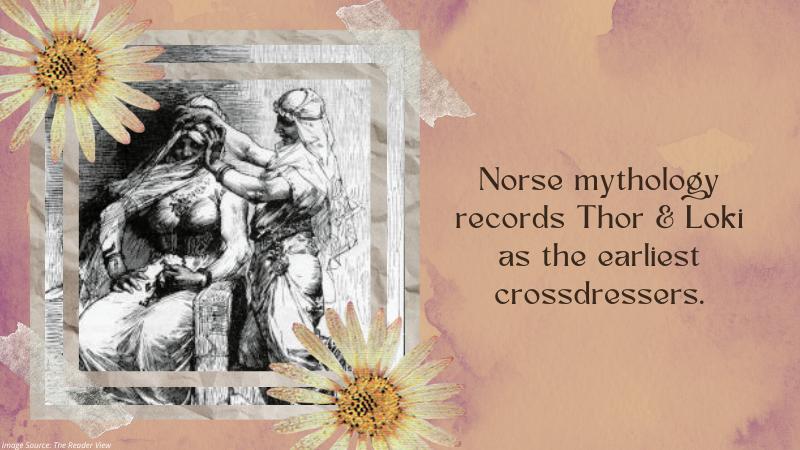
On the other hand, Norse mythology records Thor and Loki as the earliest crossdressers, and I found the story quite funny and interesting. It goes like this.
Thor woke up and found that a giant named Thrymr had stolen his hammer. Thrymr wants a wife, specifically Freyja, the Goddess of beauty, love, sexuality, fertility, gold, death, and war, to get it back. However, Freyja did not want to and fled in her chariot. Thor and Loki were left with no choice, so Thor decided to crossdress Freyja and Loki as her handmaid.
When they arrived at the wedding ceremony, Thor dressed as Freyja ate thirty giant men, and Thymry was shocked. Loki reassured the giant that his soon-to-be wife was just excited to marry him. When Thrymr was placed on “Freyja’s” lap as a wedding ceremony ritual, Thor removed his veil and slaughtered all the giants.
● Hindu

There is not much I had found with Hindu mythology, only that the goddess Bahuchara Mata cursed Bapiya in one legend and was only lifted when he crossdressed as a woman and worshiped the goddess. Another interesting story was about Krishna’s devotees crossdressing in female attires to show their devotion and loyalty to one of Hindu’s supreme deities.
2. Literature, On-Stage Shows and Plays
I love watching stage plays, especially Shakespearean adaptations! So I got interested upon learning that some of the shows I watched featured crossdresser characters, including Twelfth Night, The Merchant of Venice, The Taming of the Shrew, and The Two Gentlemen of Verona.

Several male protagonists were crossdressing as women in these plays and were viewed as ideal because they’re generally stronger, tougher, and more decisive.
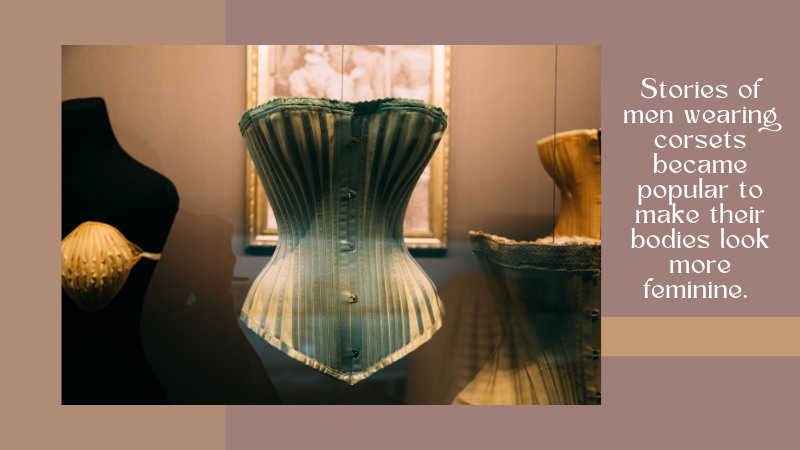
In literature, erotized female clothing became a trend in the nineteenth century, with stories of men wearing corsets becoming popular to make their bodies look more feminine. Women’s clothing also dominated during the early twentieth century – from bras, heels, tonylon stockings. Some literature also presented that men who crossdressed and wore these erotized clothing pieces would get an orgasm.
3. Countries
Different countries also have different versions of the history of crossdressing. Thankfully, I have friends from all over the world who shared most of these stories with me.
● Spain and Latin America
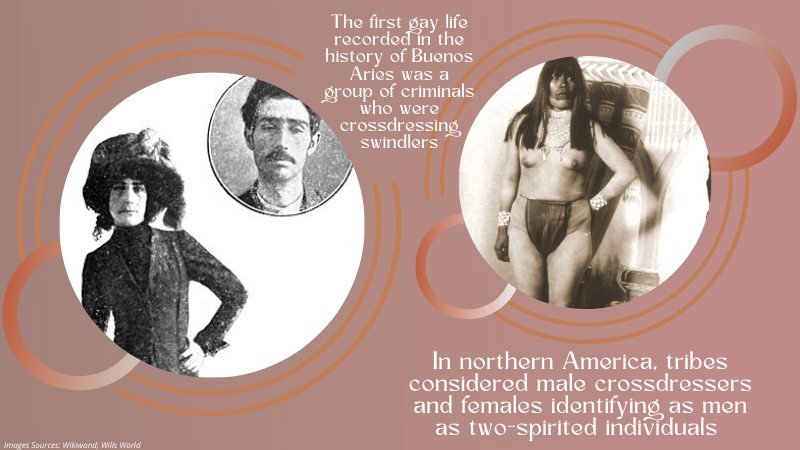
In the late 19th to early 20th century, several crossdressers emerged among all the social classes in Buenos Aires. The first gay life recorded in the history of Buenos Aries was a group of criminals who were crossdressing swindlers. This group consisted of 3000 men and represented fifty percent of the entire male population of Buenos Aires.
Based on several historical books, upper- and middle-class men attended several clandestine crossdressing balls, especially in the mid-20th century.
In northern America, tribes considered male crossdressers and females identifying as men as two-spirited individuals and were believed to be blessed and fortunate. These two-spirited Northern Americans were seen as more flexible in sustaining and caring for the lives of their families.
● Europe

From where I am from, male crossdressing was a tradition in the olden times to join social protests. Male peasants dressed as women to participate in violence, vandalism, kidnapping, and theft as they demanded social justice. These individuals believed that crossdressing made them look less threatening and symbolized their resistance to the community leaders who failed their social responsibilities.
● United States
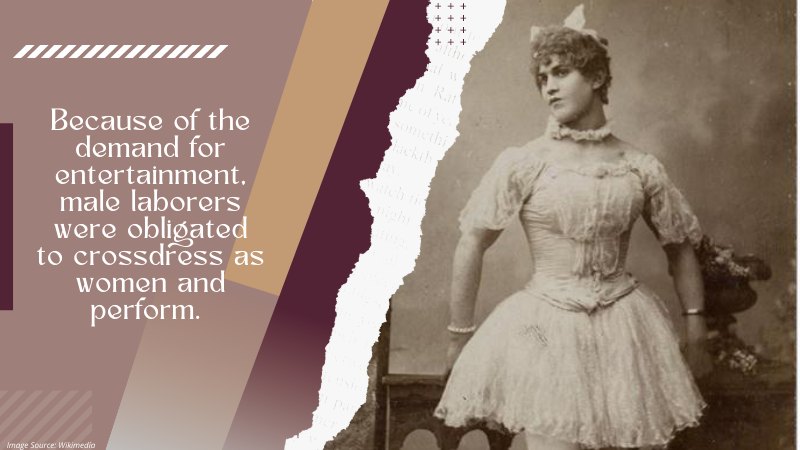
The crossdressing history in the United States is quite controversial, as there were several US laws banning crossdressing in the country. During the gold rush, which took place last 1849, a mass global migration of male laborers occurred to Northern California. This led to a massive population increase and an increased demand for all types of commodities such as tools, food, sex, and entertainment.
Because of the demand for entertainment, male laborers were obligated to crossdress as women and perform. However, they were not permitted to dress as females to let people discover their real gender identity. Several cities in the US also formulated regulations on banning crossdressing because it’s believed to be an act of immoral sexual perversion.
● France

Several French novelists and diplomats also crossdressed as women to reveal their true inner identity. For instance, Chevalier d’Eon, a famous diplomat and soldier, lived the latter half of his life crossdressing and identifying as a woman.
● England and Scotland

Both England and Scotland used crossdressing during theatrical plays, with most men dressing as women to play female roles. During the 18th century, several clubs in London developed a crossdressing culture where men dressed up as women in male bars and hung out. A famous club in London that did this was Molly House.
● Modern Thailand

In Thailand, one of the countries I’ve recently been to presents a more modern culture where crossdressers are more widely accepted than other countries in Asia. Ladyboys or Kathoey were what the Thai call men who adopted women’s clothes and mannerisms.
When I was in Thailand, I saw ladyboys, and trust me; some were even prettier than straight women! Ladyboys were rampant in the tourism and entertainment industry, as well as cosmetics and restaurants.
However, on a sadder note, even when there were several ladyboys in Thailand, a few I know still experienced workplace discrimination.
4. Crossdressing Organizations
If we have crossdressing support groups and agencies where we can feel safe to express our true gender identities, there were also organizations in the past that protected the rights of crossdressers.
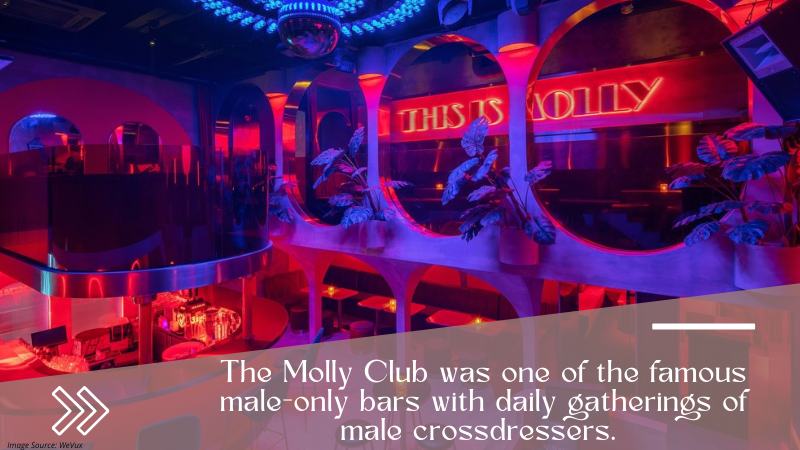
During the 18th century in London, most members of the male-only clubs would crossdress as women, meet together to party, and talk about their lives. As mentioned earlier, the Molly Club was one of the famous male-only bars with daily gatherings of male crossdressers. Several historians believed that these habits were part of their attempts to establish and welcome a gay identity into their society.
5. Significant Role in Gay Communities
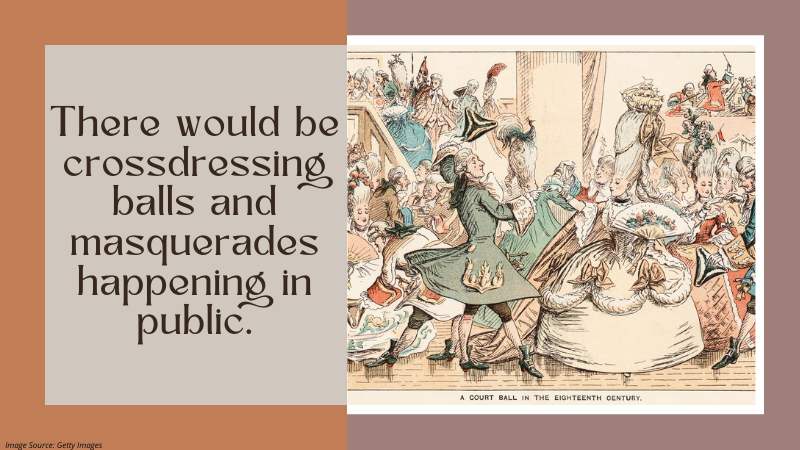
Even when not everyone accepted people crossdressing during the late 19th to early 20th century, it had a major role in establishing gay communities. Frequently, there would be crossdressing balls and masquerades happening in public where any crossdresser can join. With this came a significant increase in the number of people interested in crossdressing, especially in urban centers.
6. Crossdressing Challenges Differences Between Men and Women
In the olden times, impersonation and crossdressing were easier for women than men because of the men’s beards. Women can simply wear fake beards when performing older men’s roles on stage. On the other hand, only young males were accepted to perform during stage plays and theatrical shows because their beards had not yet fully developed.

Women who wear loose clothing can easily transform into men, while men have to wear additional layers of cover-ups and other materials to imitate the curvy figures of women. Aside from that, there were more records of women crossdressing as men to serve the military and fight in wars.
7. Crossdressing is an Art
Crossdressing being around in the past and even in different mythologies proves that this beautiful art is a norm, not just a trend that would disappear after some time.
Personally, the stories about how crossdressing dominated even different literature and most countries in the past got me excited and prouder about being a crossdresser. These stories prove that what we do is an art, and we should not be ashamed of it.
What other stories in the past about crossdressing do you know? Let me know in the comments below!
Tagged With:Dressed as a Woman Stories , History of Crossdressing , Men Dressed
1 comment
Leave a Reply
- Breaking Gender Norms: Why Gender Expression Is a Playground, Not a Cage
- Why 2025 Is the Best Time to Start Crossdressing and Express Your True Self
- The Truth About Crossdressing: History, Meaning, and Misunderstandings
- Joining TVChix: The Online Space That Changed My CD Experience
- Praise vs. Degradation: What Fuels Your Feminine Journey?
- How to Support and Navigate Life with a Crossdressing Husband
Established in 2009, We are a recognized manufacturer and seller of professional crossdressing products.
It is our aim to become not just the most creative manufacturer but also a very considerate seller, as we provide the best quality products for crossdressers all around the world.
























 Breast Forms
Breast Forms  Body Suit
Body Suit  Realistic Mask
Realistic Mask  Femini Girdle
Femini Girdle Hip & Butt Enhancement (8)
Hip & Butt Enhancement (8) Penis Prosthesis
Penis Prosthesis Fake Muscle
Fake Muscle Bikini
Bikini  Wig
Wig  Corsets
Corsets Course
Course service@roanyer.com
service@roanyer.com +8618652200711
+8618652200711 Facebook
Facebook YouTube
YouTube Twitter
Twitter Instagram
Instagram





Hi what you do is amazing and I want to be a good crossdress like you